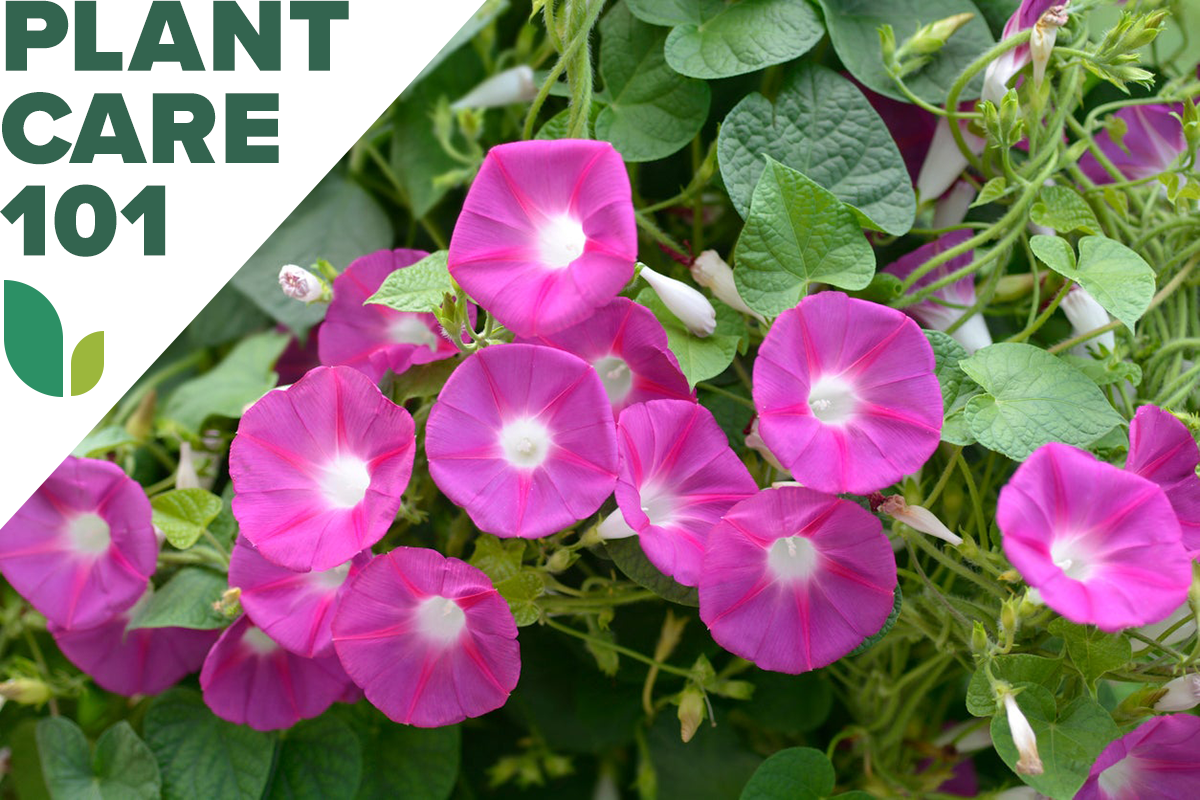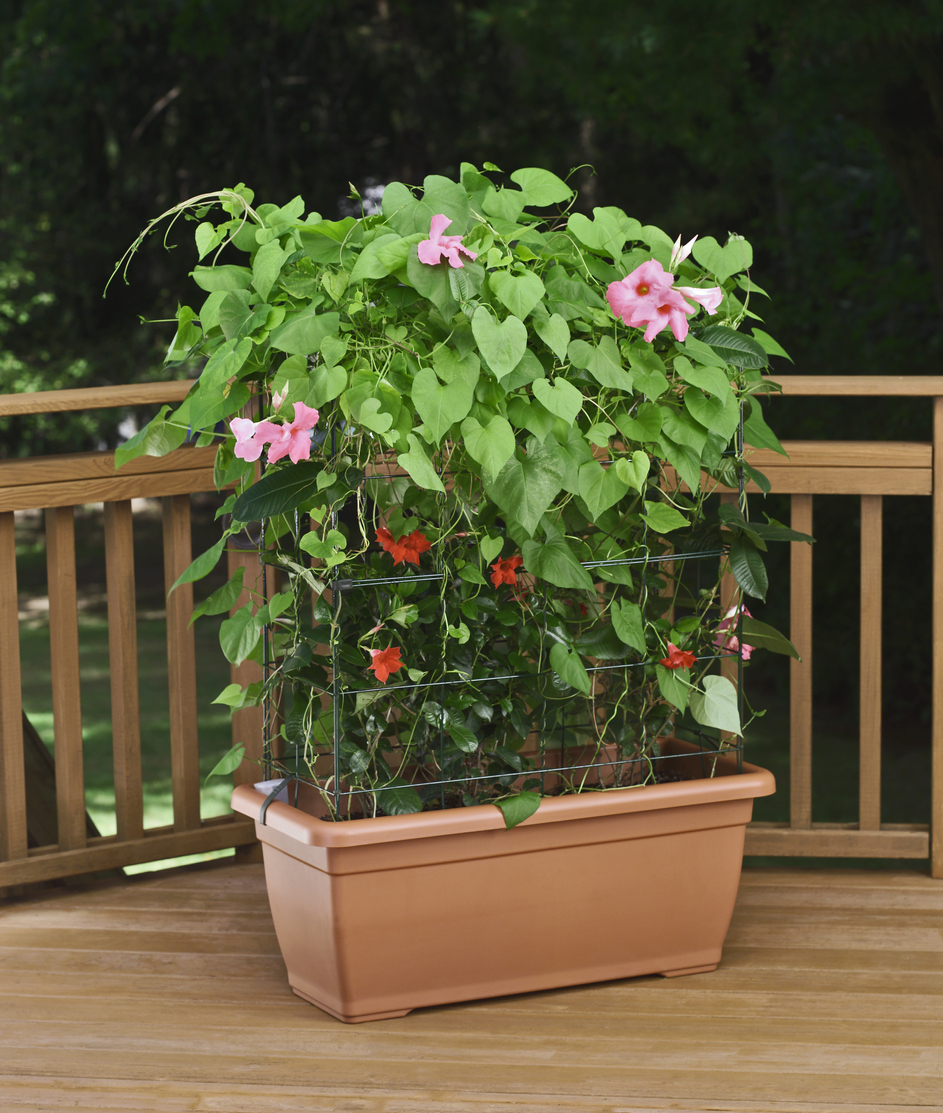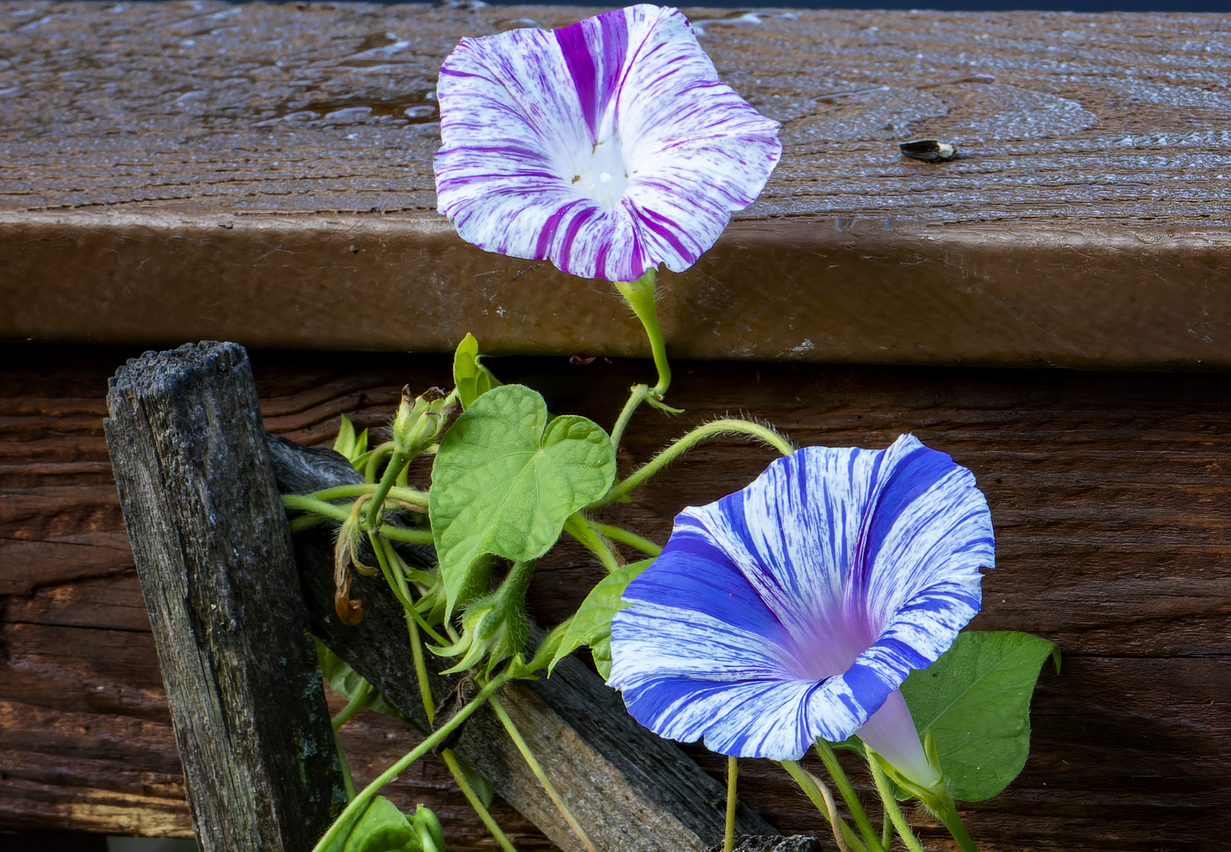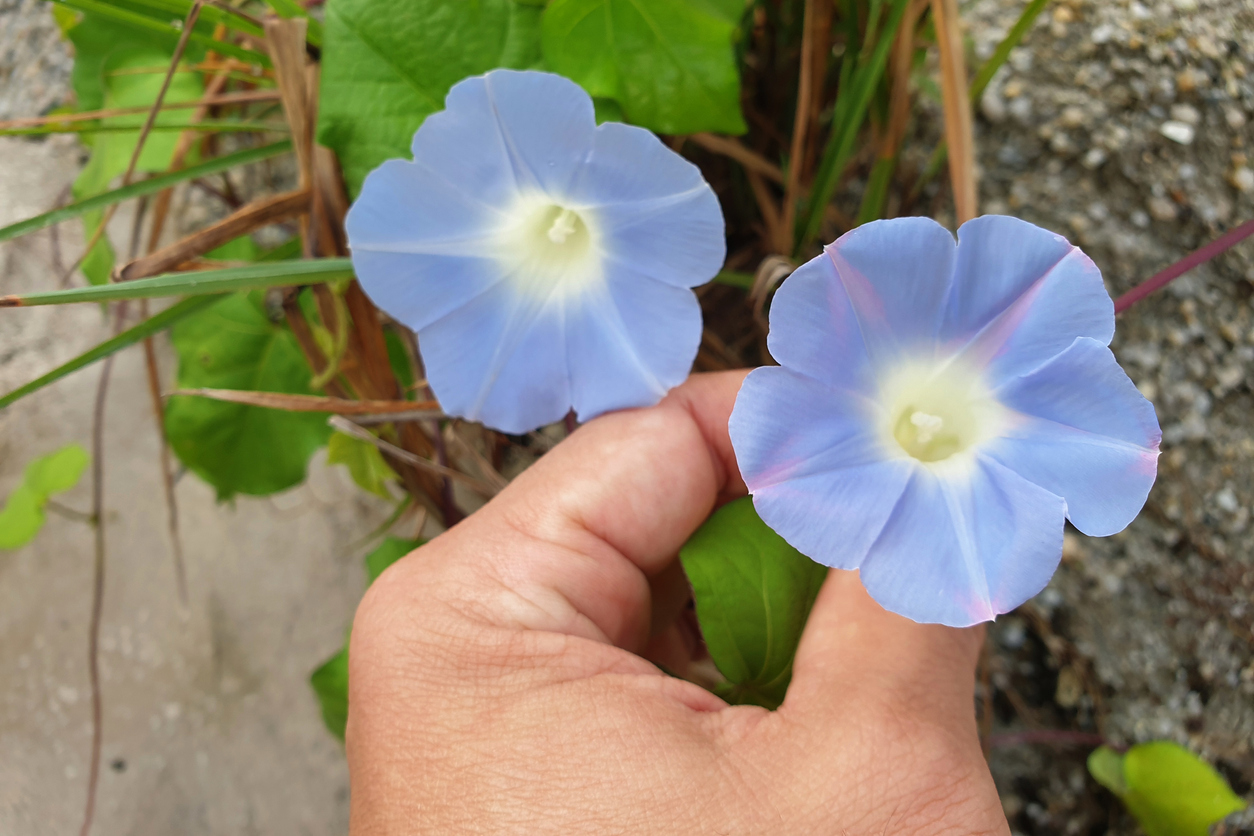

We may earn revenue from the products available on this page and participate in affiliate programs. Learn More ›
With heart-shaped leaves and funnel-shaped blooms, the vining morning glories called Ipomoeas only need something on which to climb to clothe themselves in glorious color. The annual flowers usually close by midafternoon on sunny days, though they may stay open longer on overcast ones.
A member of the Convolvulaceae family, morning glory suffers from an identity crisis of sorts. Although the annual flower can become invasive by seeding nearby, most of its cousins—such as field bindweed—are classified as noxious weeds and prohibited in some states. They are tough to eliminate once they take hold in the garden. To further confuse the matter, people often call all of the related plants the common name of “morning glory.” The weedy cousins tend to have smaller, less dramatic flowers; tightly clinging vines; and a taproot to make them even harder to pull!
Since the laid-back ornamental flower doesn’t require fertilizer and reportedly blooms most prolifically in poor soil, morning glory care is easy—perhaps too easy. The vines’ tendency to spread and become invasive through self-sowing keeps even some cultivated types on noxious weed lists in many areas. They are less of a problem in some climates and when growing native or ornamental annual types of the flower.
Growing Morning Glory at a Glance
Common Name: Morning glory
Scientific Name: Ipomoea purpurea (and some Convolvulus spp.)
Hardiness Zone: USDA zones 2 through 10 as annuals; about 8 to 12 for perennials
Soil: Only moderately fertile, well draining
Light: Full sun
Water: Moderate
Food: Low-nitrogen fertilizer
Propagation: Seed
Safety: Toxic
Morning Glory Characteristics

The Convolvulaceae family includes hundreds of plants, one being the sweet potato. However, cultivars commonly grown by gardeners mostly derive from the Ipomoea purpurea, I. nil, or I. tricolor species.
Ipomoea vines climb 6 to 12 feet and twine in a clockwise direction, but some Convolvulus types don’t surpass 1 foot in height and branch rather than twine. The size of a hummingbird-attracting funnel-shaped morning glory flower also varies from 1 to 2 inches in diameter for low-growing Convolvulus native species to 2½ inches for Ipomoea purpurea varieties, and up to nearly 6 inches for I. nil and I. tricolor cultivars.
When do morning glories bloom? Direct-sown plants typically begin flowering in late summer, while those started early indoors may bloom all summer. Originating in Mexico and Central America, the usually grown-as-an-annual vines can be perennial in USDA zones 9 to 12.
Recommended Morning Glory Varieties
- Ipomoea purpurea: Usually growing only from 6 to 10 feet high with flowers up to 2½ inches across, this species produced the Grandpa Ott heirloom ideal for purple monochromatic gardens as well as other purple, pink, and white varieties.
- Ipomoea tricolor: The species responsible for blue morning glories such as the ever popular Heavenly Blue cultivar, tricolor typically grows to about 10 feet with blooms at least 3 inches in diameter in sky-colored hues.
- Ipomoea nil: Showy Japanese morning glories and other large-flowered types derive from this species, which can grow to 12 feet with blooms to 6 inches in diameter.
- Convolvulus sabatius: This “ground morning glory” with oval foliage doesn’t surpass a foot in height and makes an easy ground cover with light blue 1- to 2-inch flowers that bloom all day. It is a perennial ground cover that is not as invasive as some in its species.
- Convolvulus tricolor: Also known as “dwarf morning glory,” this species grows 6 inches to 1 foot high with oval leaves and flowers 1½ inches across, which remain open all day and are similar to Ipomoea tricolor.
RELATED: 13 Plants You Never Knew Were Weeds

Planting Morning Glories
Since morning glories resent root disturbance, it’s a good idea to sow them directly in the ground, especially in zones with longer growing seasons. Another option is to start the seeds indoors in biodegradable containers that can be planted themselves.
When is the best time to plant morning glory?
Morning glories usually require about 2½ to 4 months to go from seed to bloom, so those sown outdoors after the last spring frost generally won’t flower until late summer and autumn. If you prefer earlier blooms, start seedlings indoors about 4 to 6 weeks before setting them out after that last frost.
Where can morning glory grow?
Choose an east-facing location that receives full sunlight all morning and has only moderately fertile soil, since an oversupply of nitrogen produces lush foliage at the expense of flowers. You can plant morning glories on the east side of arbors, buildings, or even evergreen shrubs. Keep in mind that they will require a support to twine around, so they may need a trellis or system of wires or strings to hold them against a building.
How do you plant morning glory?
Because morning glory seeds are toxic, keep them out of reach of children and pets.
- After soaking the seeds overnight, sow them ¼ to ½ inch deep in peat or coir pots—if you are starting them early indoors—or 6 inches apart if you are sowing directly in the location you have chosen.
- Once the plants have germinated and have grown 3 or 4 inches, thin or transplant morning glory seedlings to stand 1 foot apart from each other, hardening any that were started indoors before transplanting them.
- When they begin to vine, train their tips to twine in a clockwise direction around their supports.
Can you grow morning glory in containers?
Morning glories also will grow in containers, if provided with supports such as garden stakes or pot trellises. For the best results, choose pots at least 12 to 16 inches in diameter, placing three vines—evenly spaced—in the smaller size and five in the larger. If you intend to include other non-morning glory plants in your containers, use short, branching types rather than twining Ipomoea species to prevent those other plants from being throttled. This also can help contain spreading by seed or at ground level beyond the pot.
As enthusiasts have discovered, it is possible to bring morning glories in pots indoors and keep them alive on a sunny windowsill or under grow lights during the winter. But, since they are essentially outdoor plants, most gardeners will find it easier to simply sow more of them in spring.

Watering Morning Glories
Small morning glory seedlings will require the same average amount of water you give to other plants—usually the equivalent of 1 inch of rainfall per week. However, once the plants mature, they are relatively drought tolerant and can get by with less moisture, especially so if you apply 2 or 3 inches of mulch after their soil warms, which helps that soil retain its dampness. However, if the ground dries out enough that the foliage begins to wilt, it is time to water.
Fertilizing Morning Glories
As was previously mentioned, morning glories don’t need fertilizer, and high-nitrogen types may be detrimental to them, encouraging the vines to make more foliage rather than flowers. If you must feed your morning glories, choose a low-nitrogen type of plant food in which the middle (phosphorus) number of the formula is the highest one. Apply it only once per month after the plants have begun to bloom, keeping in mind that too much unnecessary phosphorus can cause polluting runoff.
Pruning Morning Glories
Because morning glory seeds are the most toxic part of the plant, it is a good idea to deadhead the flowers as soon as they fade to prevent any seeds from forming. In addition to keeping the plants blooming and looking tidy, such deadheading also will prevent them from self-sowing heavily enough to become invasive. A morning glory vine doesn’t require any other pruning, but you may want to cut it back if it threatens to encroach on—and possibly strangle—other garden plants.

Propagating Morning Glories
When growing morning glories from seed, soak the seeds overnight before you plant them. The soaking should cause the seeds to swell and crack open slightly. Then sow the seeds ¼ to ½ inch deep in seed starting mix or soil and keep them at temperatures between 65 and 85 degrees Fahrenheit. Under those conditions, they usually germinate in 4 to 7 days.
If you are starting especially hard-shelled or fuzzy morning glory seeds, which don’t take up water well, nick a small piece out of the rounded edge of each seed with a utility knife before soaking the seeds.
RELATED: How to Grow a Moon Garden at Home
Safety Considerations
All parts of the morning glory plant are toxic, with the seeds being the most poisonous. If consumed, they can cause symptoms such as vomiting, diarrhea, and hallucinations in people, pets, and livestock.
Therefore, you might want to forego morning glories if you have animals or children who are prone to sampling your garden plants. Some sources also recommend that you wear gloves when pruning or tearing down the vines to prevent possible absorption of toxins through your skin.

Potential Pests and Diseases
Since morning glories aren’t prone to disease, the number-one complaint about them usually is a failure to bloom. That could be due to some species taking a long time to flower. Other bloom-inhibiting factors besides immaturity include overfertilization or inadequate sunlight.
You may also lose seedlings to munching rabbits or slugs. To repel rabbits, sprinkle the plants with cayenne pepper immediately after setting them out. To rid yourself of the slugs, apply slug bait to the soil following the directions on the container. You may need to reapply both the pepper and slug bait after heavy rains.
Looking for more plants with showy blooms? Check out our guides on growing gerbera, hibiscus, and petunia.
